Alumina Limited's Environmental Impact
VerifiedAdded on 2020/03/28
|11
|2569
|72
AI Summary
This assignment analyzes a sustainability report from Alumina Limited, specifically examining the company's environmental impacts. The report is evaluated for its transparency, comprehensiveness, and adherence to relevant regulations. The analysis highlights both positive aspects of the report and areas where improvements could be made, such as quantifying the environmental costs associated with operations.
Contribute Materials
Your contribution can guide someone’s learning journey. Share your
documents today.
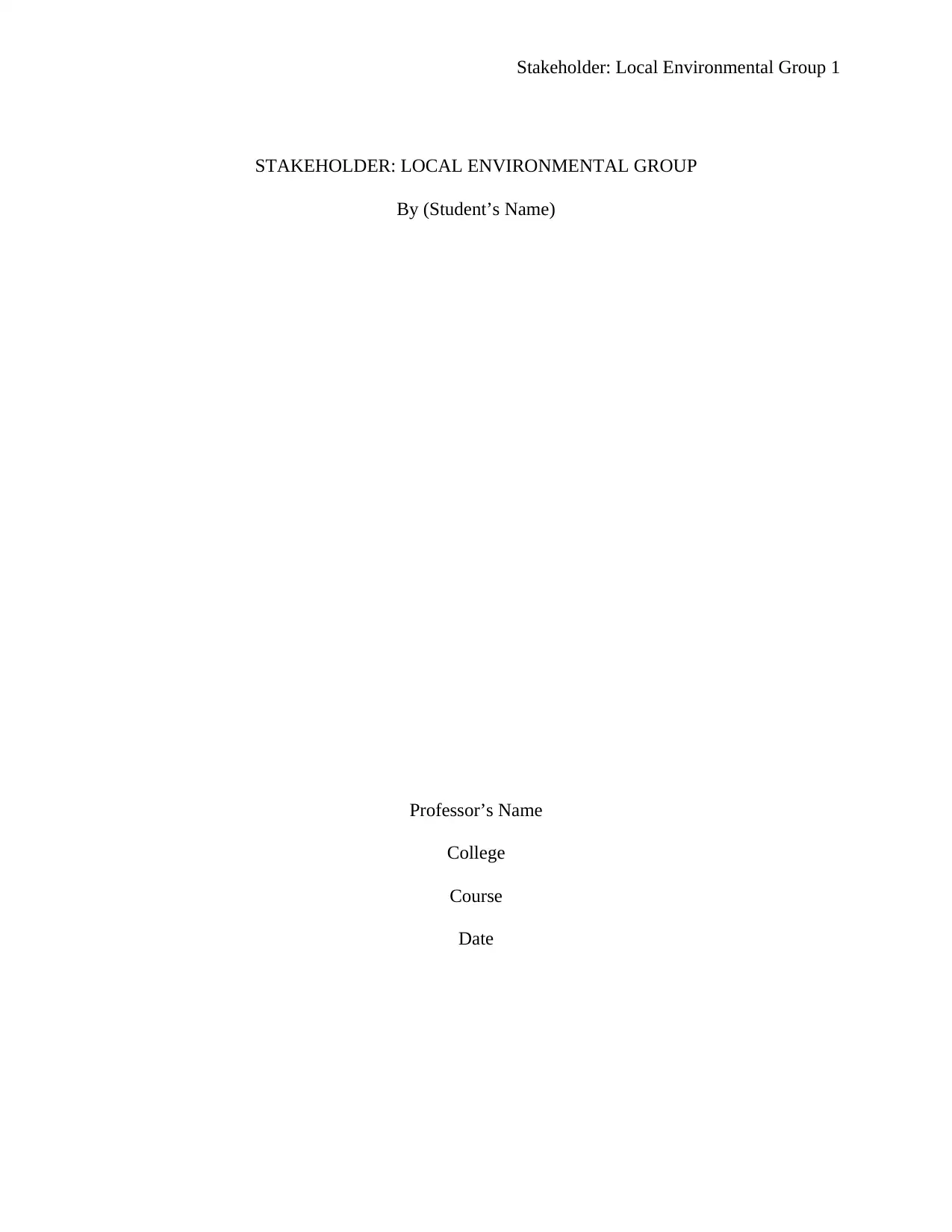
Stakeholder: Local Environmental Group 1
STAKEHOLDER: LOCAL ENVIRONMENTAL GROUP
By (Student’s Name)
Professor’s Name
College
Course
Date
STAKEHOLDER: LOCAL ENVIRONMENTAL GROUP
By (Student’s Name)
Professor’s Name
College
Course
Date
Secure Best Marks with AI Grader
Need help grading? Try our AI Grader for instant feedback on your assignments.
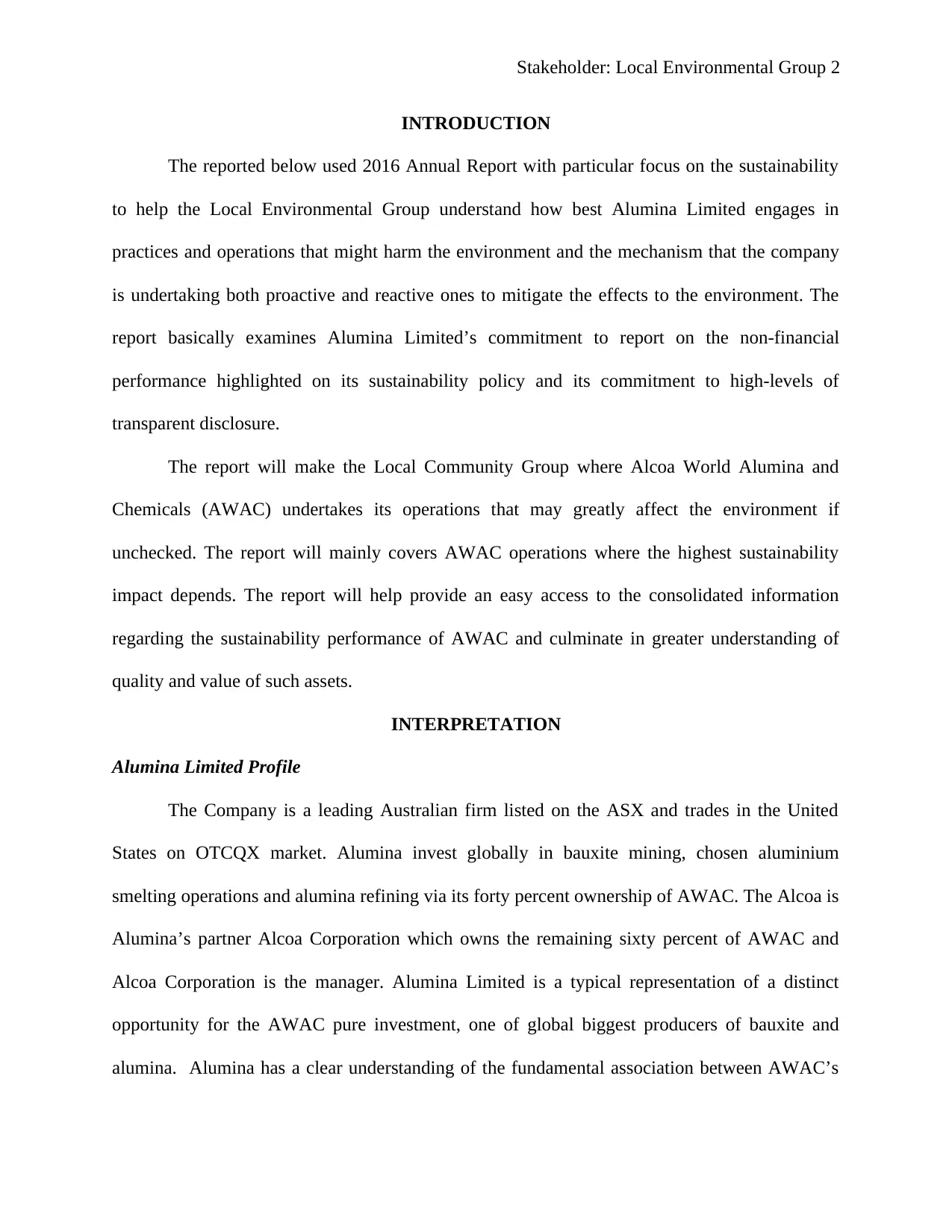
Stakeholder: Local Environmental Group 2
INTRODUCTION
The reported below used 2016 Annual Report with particular focus on the sustainability
to help the Local Environmental Group understand how best Alumina Limited engages in
practices and operations that might harm the environment and the mechanism that the company
is undertaking both proactive and reactive ones to mitigate the effects to the environment. The
report basically examines Alumina Limited’s commitment to report on the non-financial
performance highlighted on its sustainability policy and its commitment to high-levels of
transparent disclosure.
The report will make the Local Community Group where Alcoa World Alumina and
Chemicals (AWAC) undertakes its operations that may greatly affect the environment if
unchecked. The report will mainly covers AWAC operations where the highest sustainability
impact depends. The report will help provide an easy access to the consolidated information
regarding the sustainability performance of AWAC and culminate in greater understanding of
quality and value of such assets.
INTERPRETATION
Alumina Limited Profile
The Company is a leading Australian firm listed on the ASX and trades in the United
States on OTCQX market. Alumina invest globally in bauxite mining, chosen aluminium
smelting operations and alumina refining via its forty percent ownership of AWAC. The Alcoa is
Alumina’s partner Alcoa Corporation which owns the remaining sixty percent of AWAC and
Alcoa Corporation is the manager. Alumina Limited is a typical representation of a distinct
opportunity for the AWAC pure investment, one of global biggest producers of bauxite and
alumina. Alumina has a clear understanding of the fundamental association between AWAC’s
INTRODUCTION
The reported below used 2016 Annual Report with particular focus on the sustainability
to help the Local Environmental Group understand how best Alumina Limited engages in
practices and operations that might harm the environment and the mechanism that the company
is undertaking both proactive and reactive ones to mitigate the effects to the environment. The
report basically examines Alumina Limited’s commitment to report on the non-financial
performance highlighted on its sustainability policy and its commitment to high-levels of
transparent disclosure.
The report will make the Local Community Group where Alcoa World Alumina and
Chemicals (AWAC) undertakes its operations that may greatly affect the environment if
unchecked. The report will mainly covers AWAC operations where the highest sustainability
impact depends. The report will help provide an easy access to the consolidated information
regarding the sustainability performance of AWAC and culminate in greater understanding of
quality and value of such assets.
INTERPRETATION
Alumina Limited Profile
The Company is a leading Australian firm listed on the ASX and trades in the United
States on OTCQX market. Alumina invest globally in bauxite mining, chosen aluminium
smelting operations and alumina refining via its forty percent ownership of AWAC. The Alcoa is
Alumina’s partner Alcoa Corporation which owns the remaining sixty percent of AWAC and
Alcoa Corporation is the manager. Alumina Limited is a typical representation of a distinct
opportunity for the AWAC pure investment, one of global biggest producers of bauxite and
alumina. Alumina has a clear understanding of the fundamental association between AWAC’s
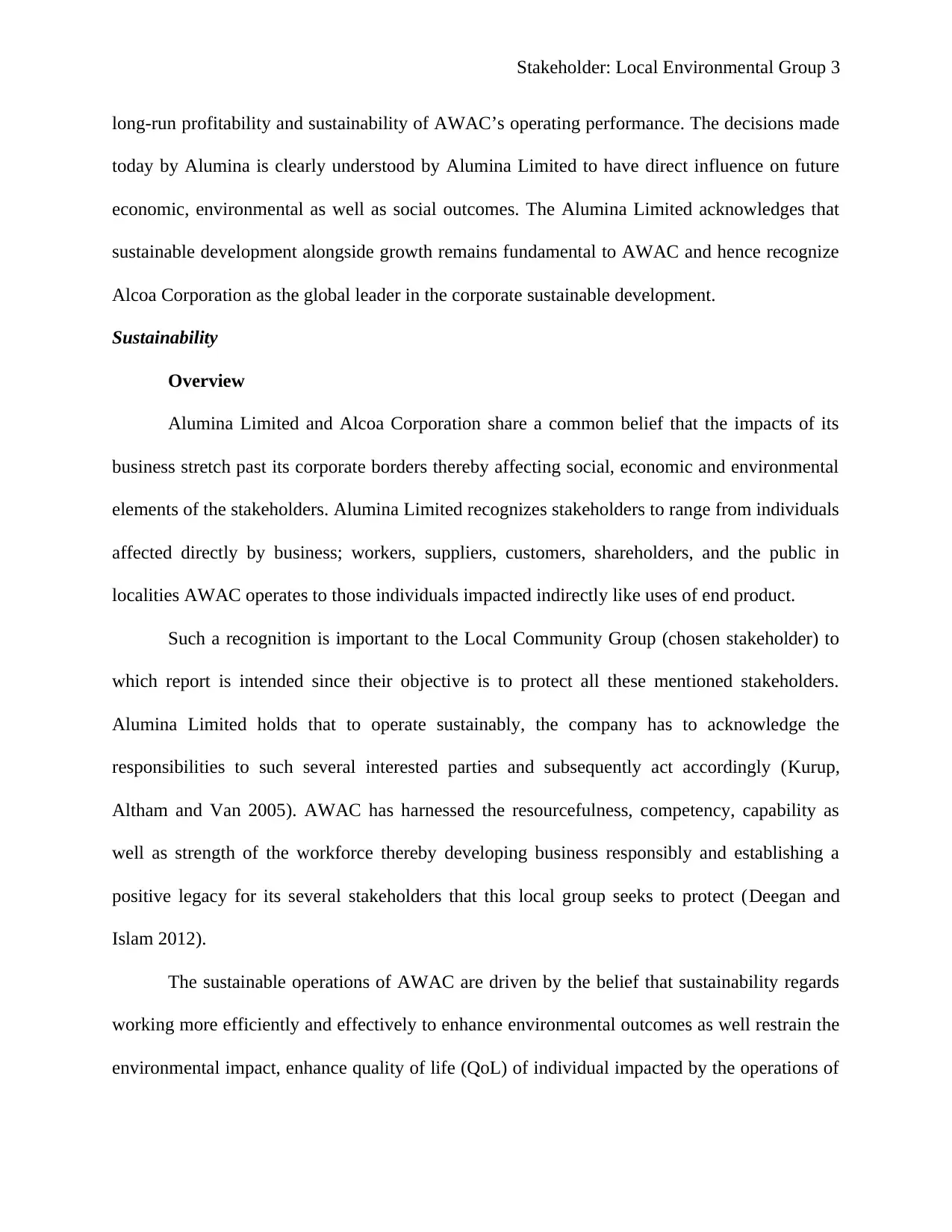
Stakeholder: Local Environmental Group 3
long-run profitability and sustainability of AWAC’s operating performance. The decisions made
today by Alumina is clearly understood by Alumina Limited to have direct influence on future
economic, environmental as well as social outcomes. The Alumina Limited acknowledges that
sustainable development alongside growth remains fundamental to AWAC and hence recognize
Alcoa Corporation as the global leader in the corporate sustainable development.
Sustainability
Overview
Alumina Limited and Alcoa Corporation share a common belief that the impacts of its
business stretch past its corporate borders thereby affecting social, economic and environmental
elements of the stakeholders. Alumina Limited recognizes stakeholders to range from individuals
affected directly by business; workers, suppliers, customers, shareholders, and the public in
localities AWAC operates to those individuals impacted indirectly like uses of end product.
Such a recognition is important to the Local Community Group (chosen stakeholder) to
which report is intended since their objective is to protect all these mentioned stakeholders.
Alumina Limited holds that to operate sustainably, the company has to acknowledge the
responsibilities to such several interested parties and subsequently act accordingly (Kurup,
Altham and Van 2005). AWAC has harnessed the resourcefulness, competency, capability as
well as strength of the workforce thereby developing business responsibly and establishing a
positive legacy for its several stakeholders that this local group seeks to protect (Deegan and
Islam 2012).
The sustainable operations of AWAC are driven by the belief that sustainability regards
working more efficiently and effectively to enhance environmental outcomes as well restrain the
environmental impact, enhance quality of life (QoL) of individual impacted by the operations of
long-run profitability and sustainability of AWAC’s operating performance. The decisions made
today by Alumina is clearly understood by Alumina Limited to have direct influence on future
economic, environmental as well as social outcomes. The Alumina Limited acknowledges that
sustainable development alongside growth remains fundamental to AWAC and hence recognize
Alcoa Corporation as the global leader in the corporate sustainable development.
Sustainability
Overview
Alumina Limited and Alcoa Corporation share a common belief that the impacts of its
business stretch past its corporate borders thereby affecting social, economic and environmental
elements of the stakeholders. Alumina Limited recognizes stakeholders to range from individuals
affected directly by business; workers, suppliers, customers, shareholders, and the public in
localities AWAC operates to those individuals impacted indirectly like uses of end product.
Such a recognition is important to the Local Community Group (chosen stakeholder) to
which report is intended since their objective is to protect all these mentioned stakeholders.
Alumina Limited holds that to operate sustainably, the company has to acknowledge the
responsibilities to such several interested parties and subsequently act accordingly (Kurup,
Altham and Van 2005). AWAC has harnessed the resourcefulness, competency, capability as
well as strength of the workforce thereby developing business responsibly and establishing a
positive legacy for its several stakeholders that this local group seeks to protect (Deegan and
Islam 2012).
The sustainable operations of AWAC are driven by the belief that sustainability regards
working more efficiently and effectively to enhance environmental outcomes as well restrain the
environmental impact, enhance quality of life (QoL) of individual impacted by the operations of
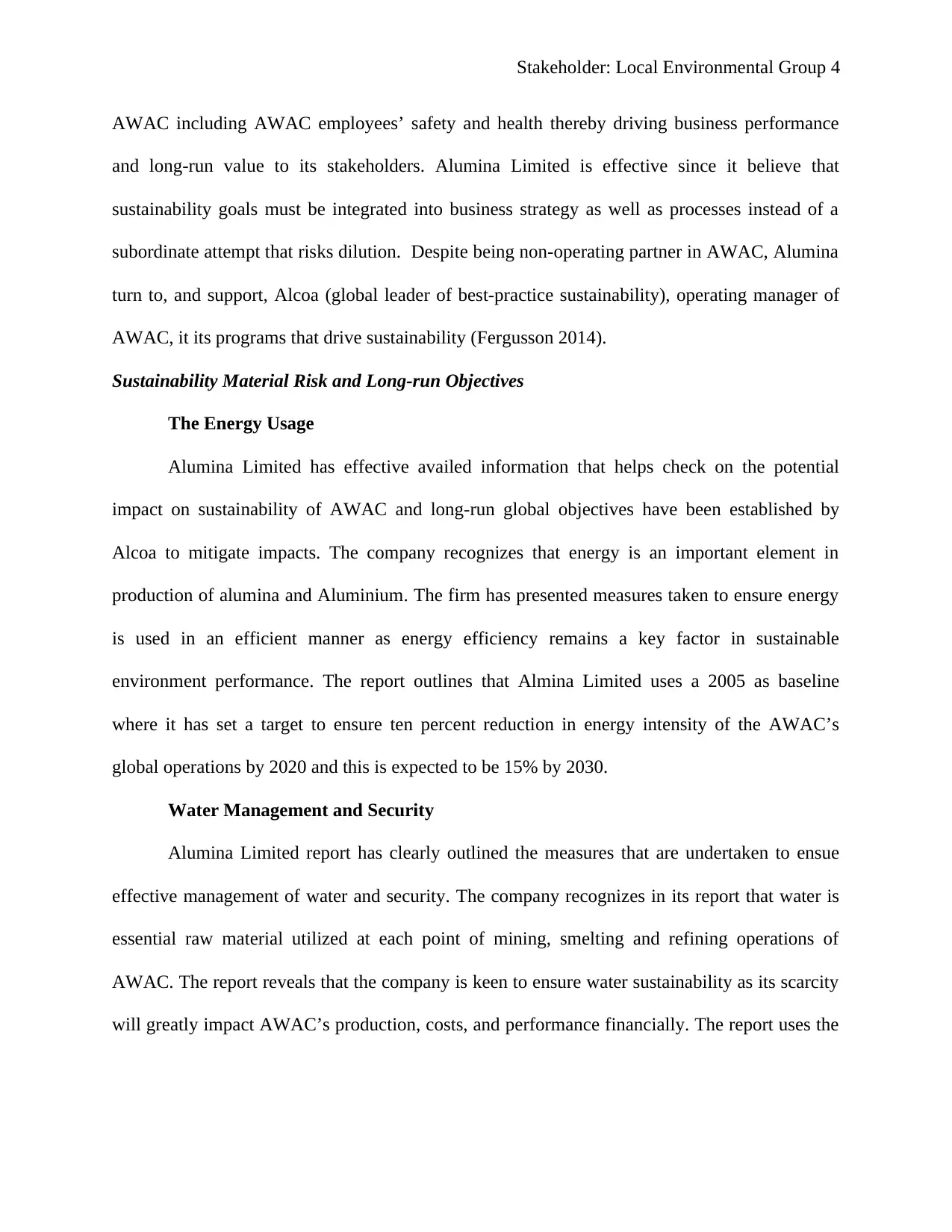
Stakeholder: Local Environmental Group 4
AWAC including AWAC employees’ safety and health thereby driving business performance
and long-run value to its stakeholders. Alumina Limited is effective since it believe that
sustainability goals must be integrated into business strategy as well as processes instead of a
subordinate attempt that risks dilution. Despite being non-operating partner in AWAC, Alumina
turn to, and support, Alcoa (global leader of best-practice sustainability), operating manager of
AWAC, it its programs that drive sustainability (Fergusson 2014).
Sustainability Material Risk and Long-run Objectives
The Energy Usage
Alumina Limited has effective availed information that helps check on the potential
impact on sustainability of AWAC and long-run global objectives have been established by
Alcoa to mitigate impacts. The company recognizes that energy is an important element in
production of alumina and Aluminium. The firm has presented measures taken to ensure energy
is used in an efficient manner as energy efficiency remains a key factor in sustainable
environment performance. The report outlines that Almina Limited uses a 2005 as baseline
where it has set a target to ensure ten percent reduction in energy intensity of the AWAC’s
global operations by 2020 and this is expected to be 15% by 2030.
Water Management and Security
Alumina Limited report has clearly outlined the measures that are undertaken to ensue
effective management of water and security. The company recognizes in its report that water is
essential raw material utilized at each point of mining, smelting and refining operations of
AWAC. The report reveals that the company is keen to ensure water sustainability as its scarcity
will greatly impact AWAC’s production, costs, and performance financially. The report uses the
AWAC including AWAC employees’ safety and health thereby driving business performance
and long-run value to its stakeholders. Alumina Limited is effective since it believe that
sustainability goals must be integrated into business strategy as well as processes instead of a
subordinate attempt that risks dilution. Despite being non-operating partner in AWAC, Alumina
turn to, and support, Alcoa (global leader of best-practice sustainability), operating manager of
AWAC, it its programs that drive sustainability (Fergusson 2014).
Sustainability Material Risk and Long-run Objectives
The Energy Usage
Alumina Limited has effective availed information that helps check on the potential
impact on sustainability of AWAC and long-run global objectives have been established by
Alcoa to mitigate impacts. The company recognizes that energy is an important element in
production of alumina and Aluminium. The firm has presented measures taken to ensure energy
is used in an efficient manner as energy efficiency remains a key factor in sustainable
environment performance. The report outlines that Almina Limited uses a 2005 as baseline
where it has set a target to ensure ten percent reduction in energy intensity of the AWAC’s
global operations by 2020 and this is expected to be 15% by 2030.
Water Management and Security
Alumina Limited report has clearly outlined the measures that are undertaken to ensue
effective management of water and security. The company recognizes in its report that water is
essential raw material utilized at each point of mining, smelting and refining operations of
AWAC. The report reveals that the company is keen to ensure water sustainability as its scarcity
will greatly impact AWAC’s production, costs, and performance financially. The report uses the
Secure Best Marks with AI Grader
Need help grading? Try our AI Grader for instant feedback on your assignments.
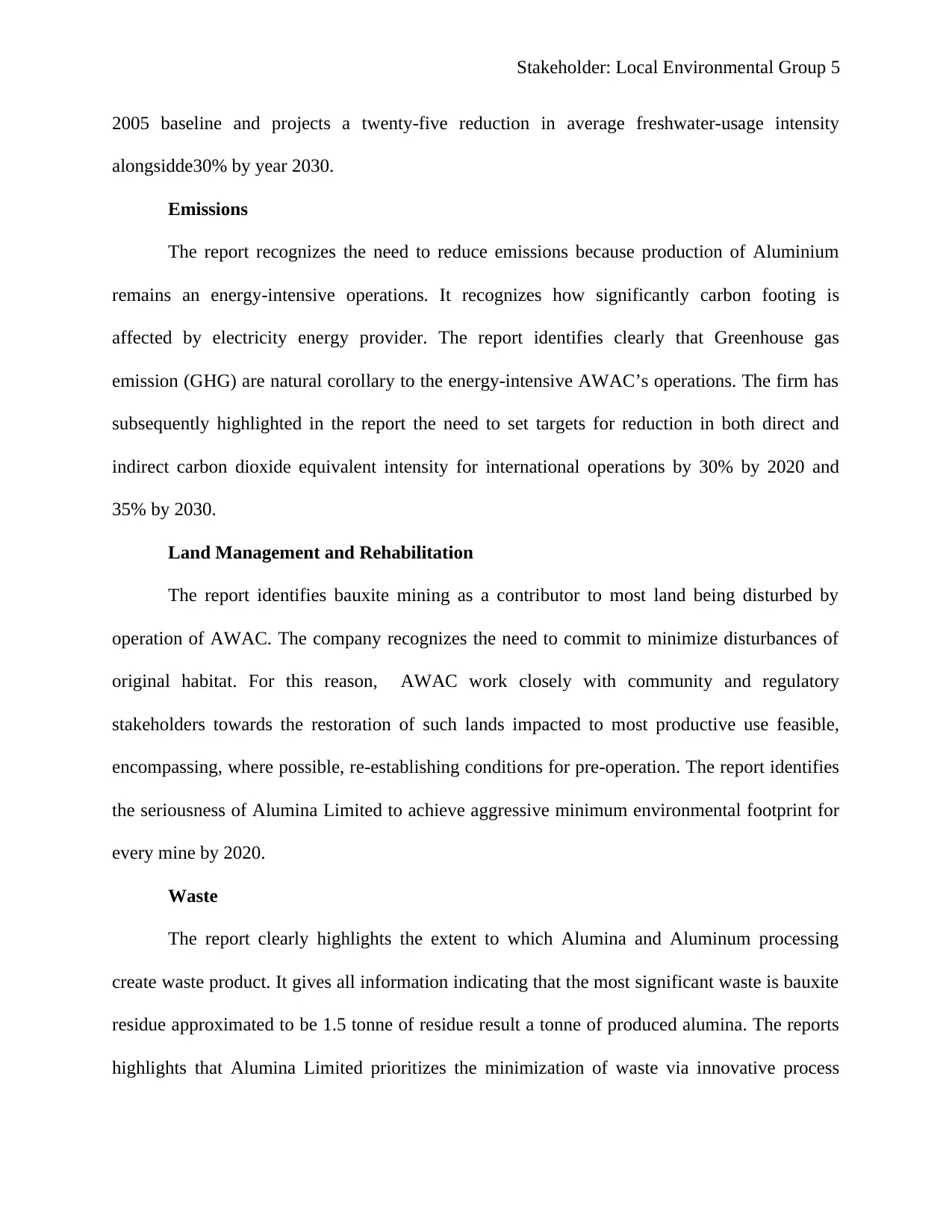
Stakeholder: Local Environmental Group 5
2005 baseline and projects a twenty-five reduction in average freshwater-usage intensity
alongsidde30% by year 2030.
Emissions
The report recognizes the need to reduce emissions because production of Aluminium
remains an energy-intensive operations. It recognizes how significantly carbon footing is
affected by electricity energy provider. The report identifies clearly that Greenhouse gas
emission (GHG) are natural corollary to the energy-intensive AWAC’s operations. The firm has
subsequently highlighted in the report the need to set targets for reduction in both direct and
indirect carbon dioxide equivalent intensity for international operations by 30% by 2020 and
35% by 2030.
Land Management and Rehabilitation
The report identifies bauxite mining as a contributor to most land being disturbed by
operation of AWAC. The company recognizes the need to commit to minimize disturbances of
original habitat. For this reason, AWAC work closely with community and regulatory
stakeholders towards the restoration of such lands impacted to most productive use feasible,
encompassing, where possible, re-establishing conditions for pre-operation. The report identifies
the seriousness of Alumina Limited to achieve aggressive minimum environmental footprint for
every mine by 2020.
Waste
The report clearly highlights the extent to which Alumina and Aluminum processing
create waste product. It gives all information indicating that the most significant waste is bauxite
residue approximated to be 1.5 tonne of residue result a tonne of produced alumina. The reports
highlights that Alumina Limited prioritizes the minimization of waste via innovative process
2005 baseline and projects a twenty-five reduction in average freshwater-usage intensity
alongsidde30% by year 2030.
Emissions
The report recognizes the need to reduce emissions because production of Aluminium
remains an energy-intensive operations. It recognizes how significantly carbon footing is
affected by electricity energy provider. The report identifies clearly that Greenhouse gas
emission (GHG) are natural corollary to the energy-intensive AWAC’s operations. The firm has
subsequently highlighted in the report the need to set targets for reduction in both direct and
indirect carbon dioxide equivalent intensity for international operations by 30% by 2020 and
35% by 2030.
Land Management and Rehabilitation
The report identifies bauxite mining as a contributor to most land being disturbed by
operation of AWAC. The company recognizes the need to commit to minimize disturbances of
original habitat. For this reason, AWAC work closely with community and regulatory
stakeholders towards the restoration of such lands impacted to most productive use feasible,
encompassing, where possible, re-establishing conditions for pre-operation. The report identifies
the seriousness of Alumina Limited to achieve aggressive minimum environmental footprint for
every mine by 2020.
Waste
The report clearly highlights the extent to which Alumina and Aluminum processing
create waste product. It gives all information indicating that the most significant waste is bauxite
residue approximated to be 1.5 tonne of residue result a tonne of produced alumina. The reports
highlights that Alumina Limited prioritizes the minimization of waste via innovative process
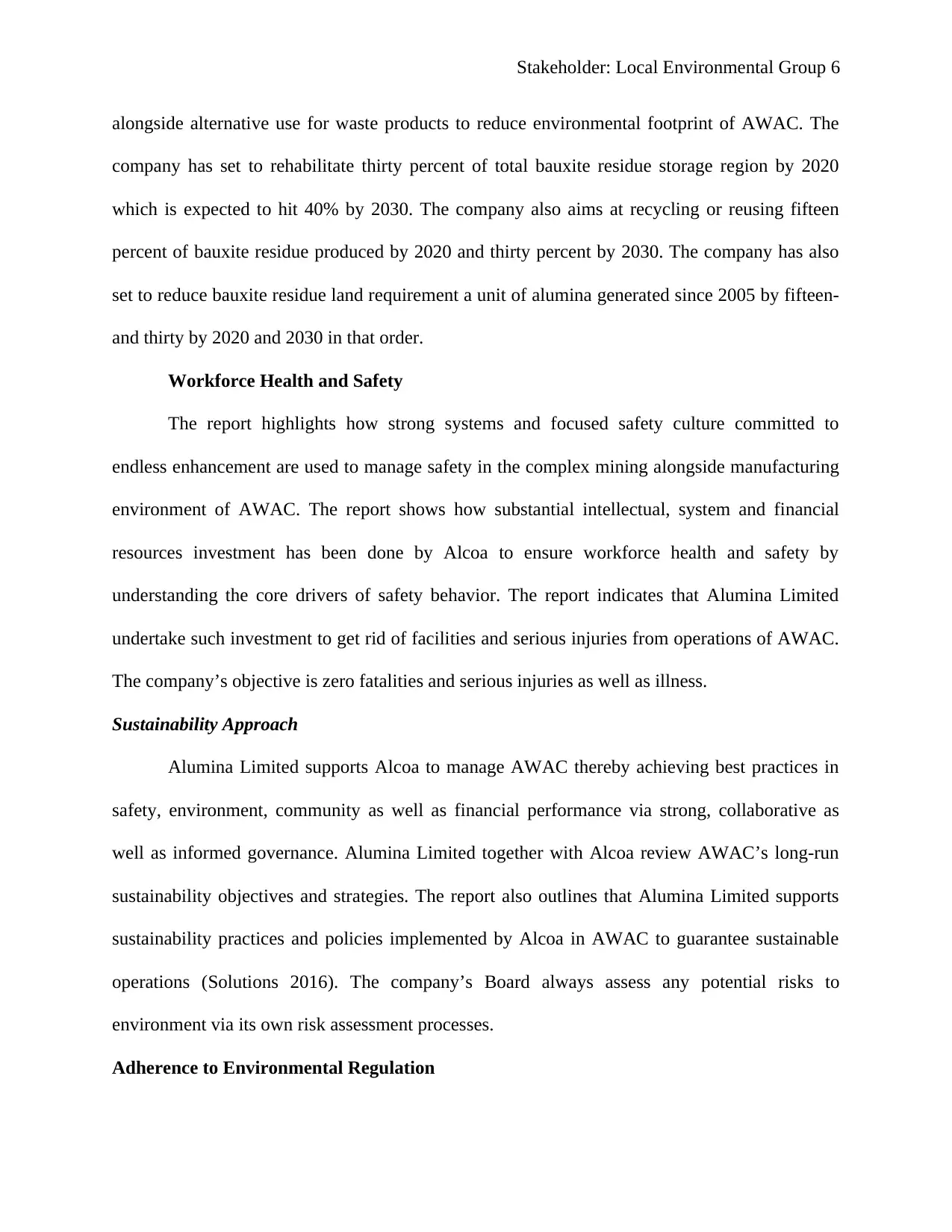
Stakeholder: Local Environmental Group 6
alongside alternative use for waste products to reduce environmental footprint of AWAC. The
company has set to rehabilitate thirty percent of total bauxite residue storage region by 2020
which is expected to hit 40% by 2030. The company also aims at recycling or reusing fifteen
percent of bauxite residue produced by 2020 and thirty percent by 2030. The company has also
set to reduce bauxite residue land requirement a unit of alumina generated since 2005 by fifteen-
and thirty by 2020 and 2030 in that order.
Workforce Health and Safety
The report highlights how strong systems and focused safety culture committed to
endless enhancement are used to manage safety in the complex mining alongside manufacturing
environment of AWAC. The report shows how substantial intellectual, system and financial
resources investment has been done by Alcoa to ensure workforce health and safety by
understanding the core drivers of safety behavior. The report indicates that Alumina Limited
undertake such investment to get rid of facilities and serious injuries from operations of AWAC.
The company’s objective is zero fatalities and serious injuries as well as illness.
Sustainability Approach
Alumina Limited supports Alcoa to manage AWAC thereby achieving best practices in
safety, environment, community as well as financial performance via strong, collaborative as
well as informed governance. Alumina Limited together with Alcoa review AWAC’s long-run
sustainability objectives and strategies. The report also outlines that Alumina Limited supports
sustainability practices and policies implemented by Alcoa in AWAC to guarantee sustainable
operations (Solutions 2016). The company’s Board always assess any potential risks to
environment via its own risk assessment processes.
Adherence to Environmental Regulation
alongside alternative use for waste products to reduce environmental footprint of AWAC. The
company has set to rehabilitate thirty percent of total bauxite residue storage region by 2020
which is expected to hit 40% by 2030. The company also aims at recycling or reusing fifteen
percent of bauxite residue produced by 2020 and thirty percent by 2030. The company has also
set to reduce bauxite residue land requirement a unit of alumina generated since 2005 by fifteen-
and thirty by 2020 and 2030 in that order.
Workforce Health and Safety
The report highlights how strong systems and focused safety culture committed to
endless enhancement are used to manage safety in the complex mining alongside manufacturing
environment of AWAC. The report shows how substantial intellectual, system and financial
resources investment has been done by Alcoa to ensure workforce health and safety by
understanding the core drivers of safety behavior. The report indicates that Alumina Limited
undertake such investment to get rid of facilities and serious injuries from operations of AWAC.
The company’s objective is zero fatalities and serious injuries as well as illness.
Sustainability Approach
Alumina Limited supports Alcoa to manage AWAC thereby achieving best practices in
safety, environment, community as well as financial performance via strong, collaborative as
well as informed governance. Alumina Limited together with Alcoa review AWAC’s long-run
sustainability objectives and strategies. The report also outlines that Alumina Limited supports
sustainability practices and policies implemented by Alcoa in AWAC to guarantee sustainable
operations (Solutions 2016). The company’s Board always assess any potential risks to
environment via its own risk assessment processes.
Adherence to Environmental Regulation
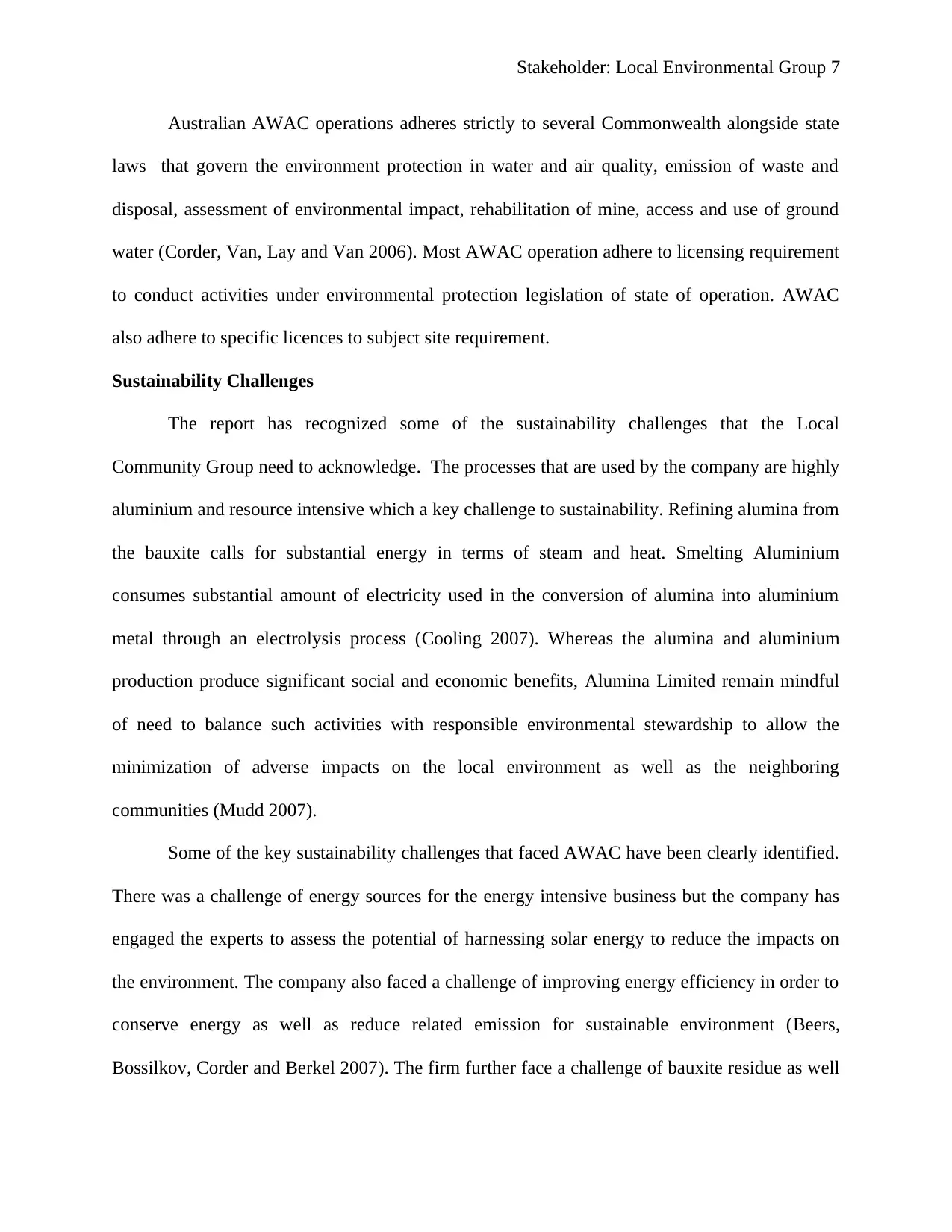
Stakeholder: Local Environmental Group 7
Australian AWAC operations adheres strictly to several Commonwealth alongside state
laws that govern the environment protection in water and air quality, emission of waste and
disposal, assessment of environmental impact, rehabilitation of mine, access and use of ground
water (Corder, Van, Lay and Van 2006). Most AWAC operation adhere to licensing requirement
to conduct activities under environmental protection legislation of state of operation. AWAC
also adhere to specific licences to subject site requirement.
Sustainability Challenges
The report has recognized some of the sustainability challenges that the Local
Community Group need to acknowledge. The processes that are used by the company are highly
aluminium and resource intensive which a key challenge to sustainability. Refining alumina from
the bauxite calls for substantial energy in terms of steam and heat. Smelting Aluminium
consumes substantial amount of electricity used in the conversion of alumina into aluminium
metal through an electrolysis process (Cooling 2007). Whereas the alumina and aluminium
production produce significant social and economic benefits, Alumina Limited remain mindful
of need to balance such activities with responsible environmental stewardship to allow the
minimization of adverse impacts on the local environment as well as the neighboring
communities (Mudd 2007).
Some of the key sustainability challenges that faced AWAC have been clearly identified.
There was a challenge of energy sources for the energy intensive business but the company has
engaged the experts to assess the potential of harnessing solar energy to reduce the impacts on
the environment. The company also faced a challenge of improving energy efficiency in order to
conserve energy as well as reduce related emission for sustainable environment (Beers,
Bossilkov, Corder and Berkel 2007). The firm further face a challenge of bauxite residue as well
Australian AWAC operations adheres strictly to several Commonwealth alongside state
laws that govern the environment protection in water and air quality, emission of waste and
disposal, assessment of environmental impact, rehabilitation of mine, access and use of ground
water (Corder, Van, Lay and Van 2006). Most AWAC operation adhere to licensing requirement
to conduct activities under environmental protection legislation of state of operation. AWAC
also adhere to specific licences to subject site requirement.
Sustainability Challenges
The report has recognized some of the sustainability challenges that the Local
Community Group need to acknowledge. The processes that are used by the company are highly
aluminium and resource intensive which a key challenge to sustainability. Refining alumina from
the bauxite calls for substantial energy in terms of steam and heat. Smelting Aluminium
consumes substantial amount of electricity used in the conversion of alumina into aluminium
metal through an electrolysis process (Cooling 2007). Whereas the alumina and aluminium
production produce significant social and economic benefits, Alumina Limited remain mindful
of need to balance such activities with responsible environmental stewardship to allow the
minimization of adverse impacts on the local environment as well as the neighboring
communities (Mudd 2007).
Some of the key sustainability challenges that faced AWAC have been clearly identified.
There was a challenge of energy sources for the energy intensive business but the company has
engaged the experts to assess the potential of harnessing solar energy to reduce the impacts on
the environment. The company also faced a challenge of improving energy efficiency in order to
conserve energy as well as reduce related emission for sustainable environment (Beers,
Bossilkov, Corder and Berkel 2007). The firm further face a challenge of bauxite residue as well
Paraphrase This Document
Need a fresh take? Get an instant paraphrase of this document with our AI Paraphraser
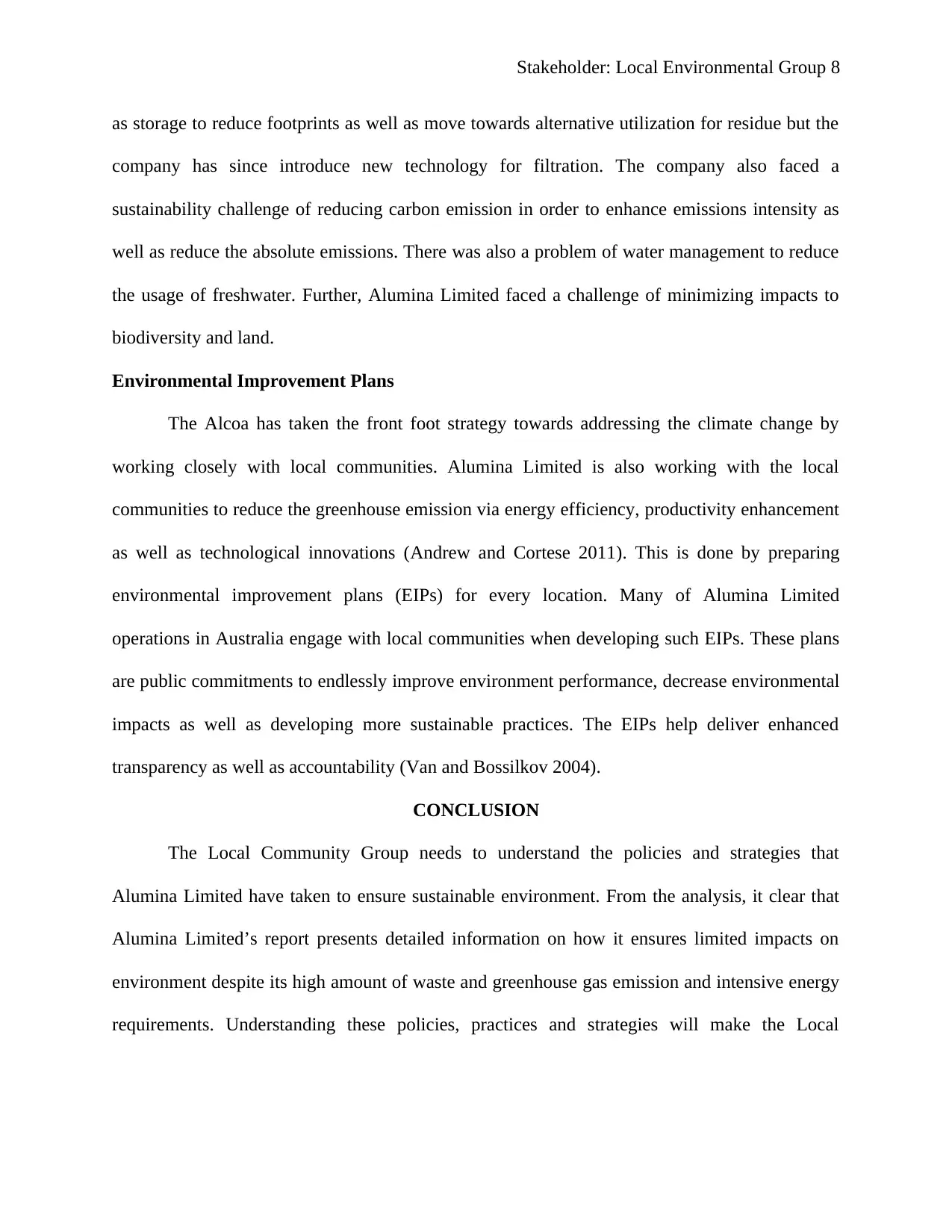
Stakeholder: Local Environmental Group 8
as storage to reduce footprints as well as move towards alternative utilization for residue but the
company has since introduce new technology for filtration. The company also faced a
sustainability challenge of reducing carbon emission in order to enhance emissions intensity as
well as reduce the absolute emissions. There was also a problem of water management to reduce
the usage of freshwater. Further, Alumina Limited faced a challenge of minimizing impacts to
biodiversity and land.
Environmental Improvement Plans
The Alcoa has taken the front foot strategy towards addressing the climate change by
working closely with local communities. Alumina Limited is also working with the local
communities to reduce the greenhouse emission via energy efficiency, productivity enhancement
as well as technological innovations (Andrew and Cortese 2011). This is done by preparing
environmental improvement plans (EIPs) for every location. Many of Alumina Limited
operations in Australia engage with local communities when developing such EIPs. These plans
are public commitments to endlessly improve environment performance, decrease environmental
impacts as well as developing more sustainable practices. The EIPs help deliver enhanced
transparency as well as accountability (Van and Bossilkov 2004).
CONCLUSION
The Local Community Group needs to understand the policies and strategies that
Alumina Limited have taken to ensure sustainable environment. From the analysis, it clear that
Alumina Limited’s report presents detailed information on how it ensures limited impacts on
environment despite its high amount of waste and greenhouse gas emission and intensive energy
requirements. Understanding these policies, practices and strategies will make the Local
as storage to reduce footprints as well as move towards alternative utilization for residue but the
company has since introduce new technology for filtration. The company also faced a
sustainability challenge of reducing carbon emission in order to enhance emissions intensity as
well as reduce the absolute emissions. There was also a problem of water management to reduce
the usage of freshwater. Further, Alumina Limited faced a challenge of minimizing impacts to
biodiversity and land.
Environmental Improvement Plans
The Alcoa has taken the front foot strategy towards addressing the climate change by
working closely with local communities. Alumina Limited is also working with the local
communities to reduce the greenhouse emission via energy efficiency, productivity enhancement
as well as technological innovations (Andrew and Cortese 2011). This is done by preparing
environmental improvement plans (EIPs) for every location. Many of Alumina Limited
operations in Australia engage with local communities when developing such EIPs. These plans
are public commitments to endlessly improve environment performance, decrease environmental
impacts as well as developing more sustainable practices. The EIPs help deliver enhanced
transparency as well as accountability (Van and Bossilkov 2004).
CONCLUSION
The Local Community Group needs to understand the policies and strategies that
Alumina Limited have taken to ensure sustainable environment. From the analysis, it clear that
Alumina Limited’s report presents detailed information on how it ensures limited impacts on
environment despite its high amount of waste and greenhouse gas emission and intensive energy
requirements. Understanding these policies, practices and strategies will make the Local
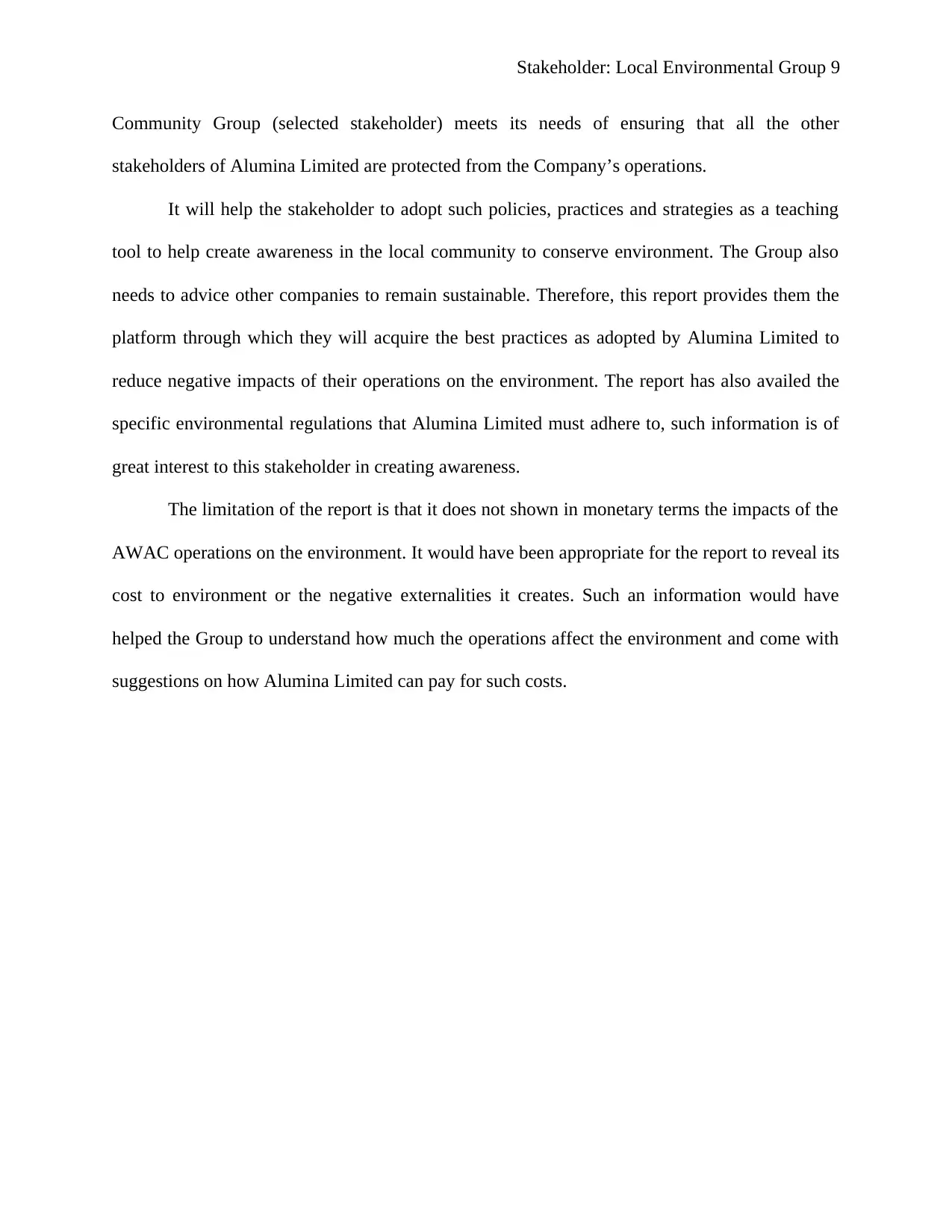
Stakeholder: Local Environmental Group 9
Community Group (selected stakeholder) meets its needs of ensuring that all the other
stakeholders of Alumina Limited are protected from the Company’s operations.
It will help the stakeholder to adopt such policies, practices and strategies as a teaching
tool to help create awareness in the local community to conserve environment. The Group also
needs to advice other companies to remain sustainable. Therefore, this report provides them the
platform through which they will acquire the best practices as adopted by Alumina Limited to
reduce negative impacts of their operations on the environment. The report has also availed the
specific environmental regulations that Alumina Limited must adhere to, such information is of
great interest to this stakeholder in creating awareness.
The limitation of the report is that it does not shown in monetary terms the impacts of the
AWAC operations on the environment. It would have been appropriate for the report to reveal its
cost to environment or the negative externalities it creates. Such an information would have
helped the Group to understand how much the operations affect the environment and come with
suggestions on how Alumina Limited can pay for such costs.
Community Group (selected stakeholder) meets its needs of ensuring that all the other
stakeholders of Alumina Limited are protected from the Company’s operations.
It will help the stakeholder to adopt such policies, practices and strategies as a teaching
tool to help create awareness in the local community to conserve environment. The Group also
needs to advice other companies to remain sustainable. Therefore, this report provides them the
platform through which they will acquire the best practices as adopted by Alumina Limited to
reduce negative impacts of their operations on the environment. The report has also availed the
specific environmental regulations that Alumina Limited must adhere to, such information is of
great interest to this stakeholder in creating awareness.
The limitation of the report is that it does not shown in monetary terms the impacts of the
AWAC operations on the environment. It would have been appropriate for the report to reveal its
cost to environment or the negative externalities it creates. Such an information would have
helped the Group to understand how much the operations affect the environment and come with
suggestions on how Alumina Limited can pay for such costs.
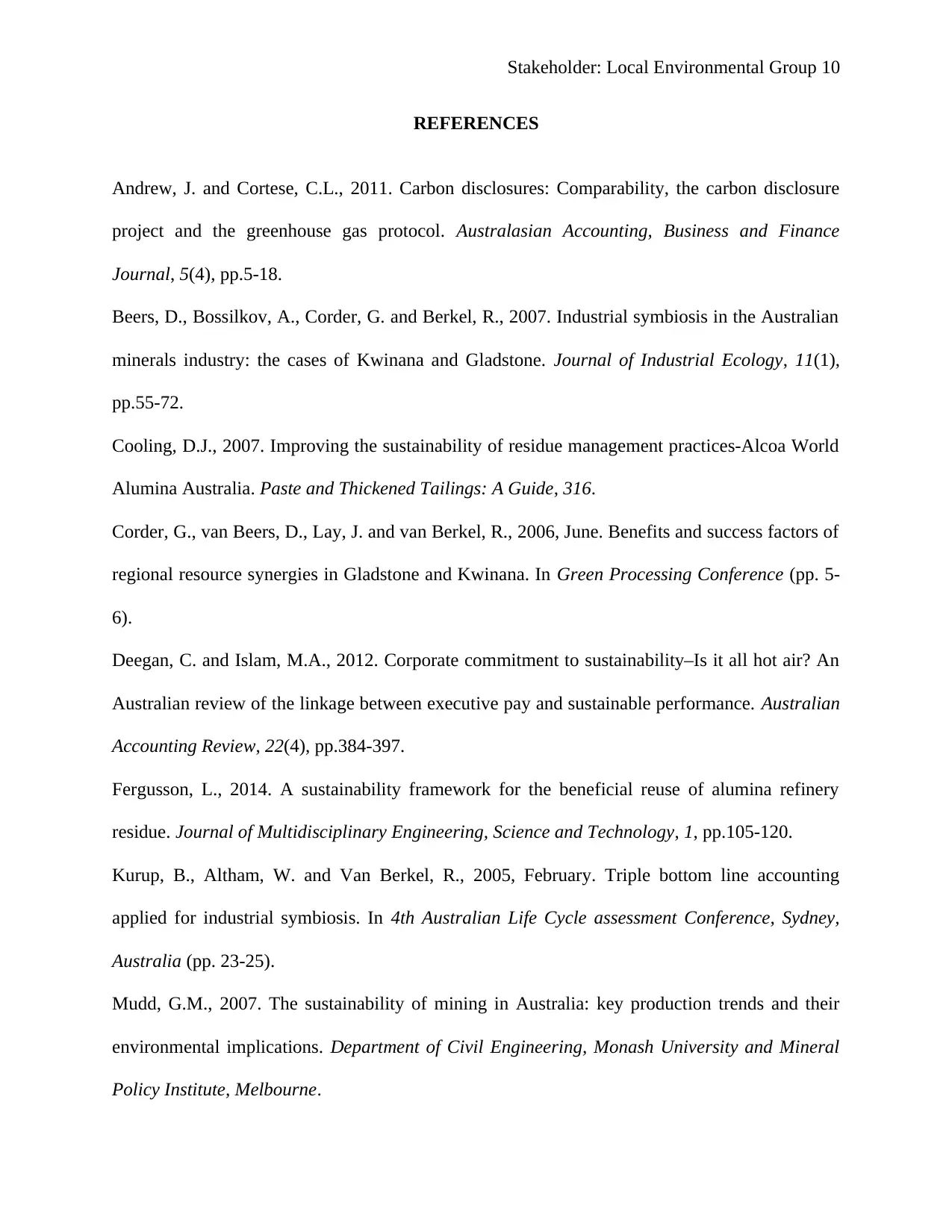
Stakeholder: Local Environmental Group 10
REFERENCES
Andrew, J. and Cortese, C.L., 2011. Carbon disclosures: Comparability, the carbon disclosure
project and the greenhouse gas protocol. Australasian Accounting, Business and Finance
Journal, 5(4), pp.5-18.
Beers, D., Bossilkov, A., Corder, G. and Berkel, R., 2007. Industrial symbiosis in the Australian
minerals industry: the cases of Kwinana and Gladstone. Journal of Industrial Ecology, 11(1),
pp.55-72.
Cooling, D.J., 2007. Improving the sustainability of residue management practices-Alcoa World
Alumina Australia. Paste and Thickened Tailings: A Guide, 316.
Corder, G., van Beers, D., Lay, J. and van Berkel, R., 2006, June. Benefits and success factors of
regional resource synergies in Gladstone and Kwinana. In Green Processing Conference (pp. 5-
6).
Deegan, C. and Islam, M.A., 2012. Corporate commitment to sustainability–Is it all hot air? An
Australian review of the linkage between executive pay and sustainable performance. Australian
Accounting Review, 22(4), pp.384-397.
Fergusson, L., 2014. A sustainability framework for the beneficial reuse of alumina refinery
residue. Journal of Multidisciplinary Engineering, Science and Technology, 1, pp.105-120.
Kurup, B., Altham, W. and Van Berkel, R., 2005, February. Triple bottom line accounting
applied for industrial symbiosis. In 4th Australian Life Cycle assessment Conference, Sydney,
Australia (pp. 23-25).
Mudd, G.M., 2007. The sustainability of mining in Australia: key production trends and their
environmental implications. Department of Civil Engineering, Monash University and Mineral
Policy Institute, Melbourne.
REFERENCES
Andrew, J. and Cortese, C.L., 2011. Carbon disclosures: Comparability, the carbon disclosure
project and the greenhouse gas protocol. Australasian Accounting, Business and Finance
Journal, 5(4), pp.5-18.
Beers, D., Bossilkov, A., Corder, G. and Berkel, R., 2007. Industrial symbiosis in the Australian
minerals industry: the cases of Kwinana and Gladstone. Journal of Industrial Ecology, 11(1),
pp.55-72.
Cooling, D.J., 2007. Improving the sustainability of residue management practices-Alcoa World
Alumina Australia. Paste and Thickened Tailings: A Guide, 316.
Corder, G., van Beers, D., Lay, J. and van Berkel, R., 2006, June. Benefits and success factors of
regional resource synergies in Gladstone and Kwinana. In Green Processing Conference (pp. 5-
6).
Deegan, C. and Islam, M.A., 2012. Corporate commitment to sustainability–Is it all hot air? An
Australian review of the linkage between executive pay and sustainable performance. Australian
Accounting Review, 22(4), pp.384-397.
Fergusson, L., 2014. A sustainability framework for the beneficial reuse of alumina refinery
residue. Journal of Multidisciplinary Engineering, Science and Technology, 1, pp.105-120.
Kurup, B., Altham, W. and Van Berkel, R., 2005, February. Triple bottom line accounting
applied for industrial symbiosis. In 4th Australian Life Cycle assessment Conference, Sydney,
Australia (pp. 23-25).
Mudd, G.M., 2007. The sustainability of mining in Australia: key production trends and their
environmental implications. Department of Civil Engineering, Monash University and Mineral
Policy Institute, Melbourne.
Secure Best Marks with AI Grader
Need help grading? Try our AI Grader for instant feedback on your assignments.
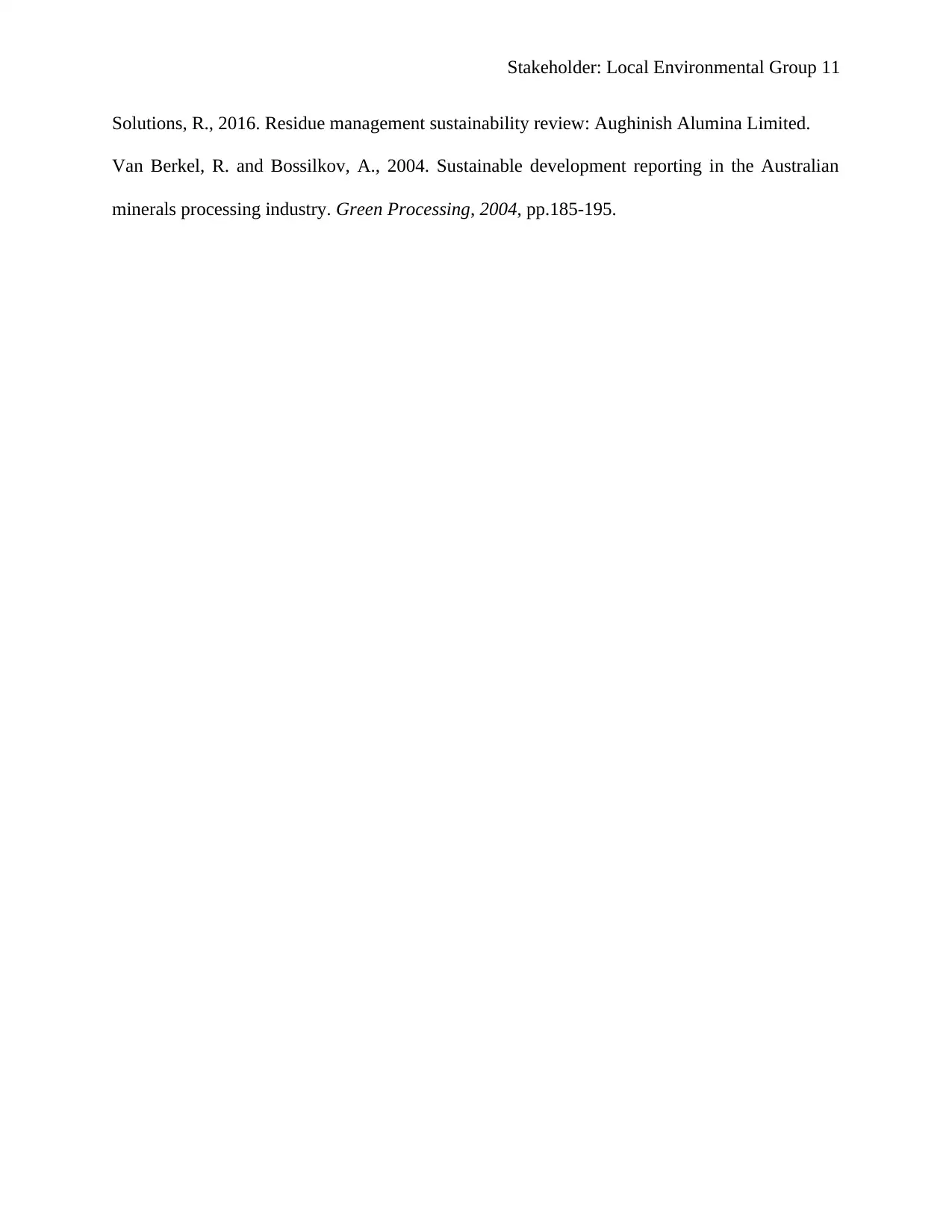
Stakeholder: Local Environmental Group 11
Solutions, R., 2016. Residue management sustainability review: Aughinish Alumina Limited.
Van Berkel, R. and Bossilkov, A., 2004. Sustainable development reporting in the Australian
minerals processing industry. Green Processing, 2004, pp.185-195.
Solutions, R., 2016. Residue management sustainability review: Aughinish Alumina Limited.
Van Berkel, R. and Bossilkov, A., 2004. Sustainable development reporting in the Australian
minerals processing industry. Green Processing, 2004, pp.185-195.
1 out of 11
Your All-in-One AI-Powered Toolkit for Academic Success.
+13062052269
info@desklib.com
Available 24*7 on WhatsApp / Email
![[object Object]](/_next/static/media/star-bottom.7253800d.svg)
Unlock your academic potential
© 2024 | Zucol Services PVT LTD | All rights reserved.





